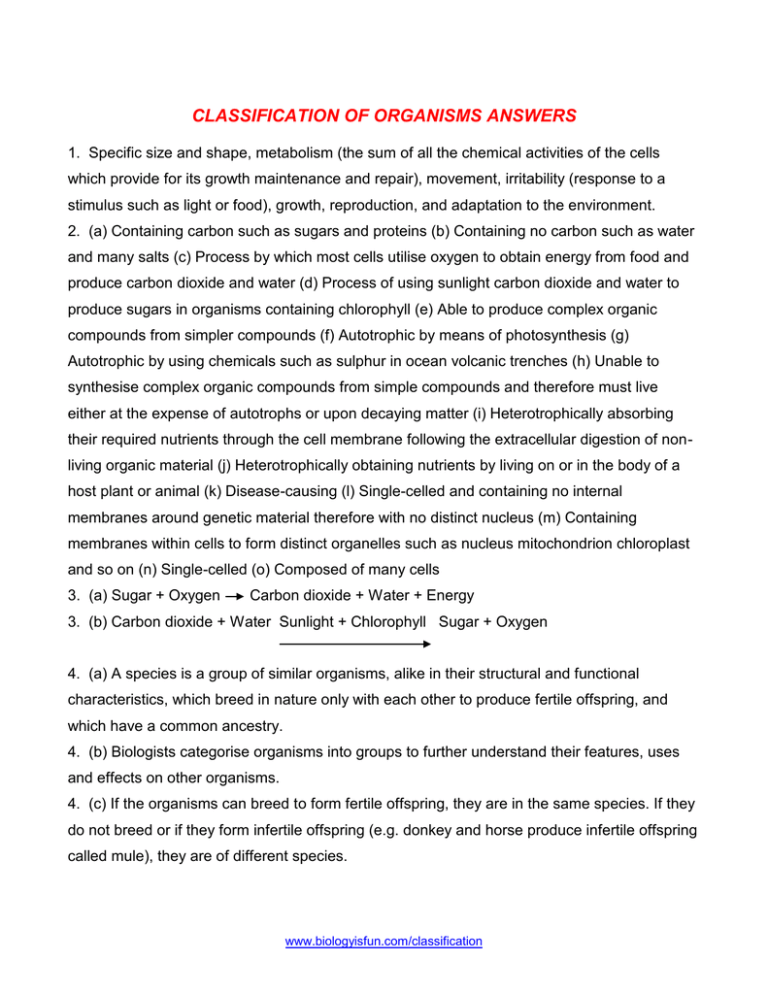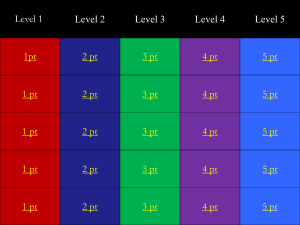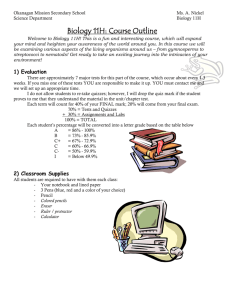CLASSIFICATION OF ORGANISMS ANSWERS
advertisement

CLASSIFICATION OF ORGANISMS ANSWERS 1. Specific size and shape, metabolism (the sum of all the chemical activities of the cells which provide for its growth maintenance and repair), movement, irritability (response to a stimulus such as light or food), growth, reproduction, and adaptation to the environment. 2. (a) Containing carbon such as sugars and proteins (b) Containing no carbon such as water and many salts (c) Process by which most cells utilise oxygen to obtain energy from food and produce carbon dioxide and water (d) Process of using sunlight carbon dioxide and water to produce sugars in organisms containing chlorophyll (e) Able to produce complex organic compounds from simpler compounds (f) Autotrophic by means of photosynthesis (g) Autotrophic by using chemicals such as sulphur in ocean volcanic trenches (h) Unable to synthesise complex organic compounds from simple compounds and therefore must live either at the expense of autotrophs or upon decaying matter (i) Heterotrophically absorbing their required nutrients through the cell membrane following the extracellular digestion of nonliving organic material (j) Heterotrophically obtaining nutrients by living on or in the body of a host plant or animal (k) Disease-causing (l) Single-celled and containing no internal membranes around genetic material therefore with no distinct nucleus (m) Containing membranes within cells to form distinct organelles such as nucleus mitochondrion chloroplast and so on (n) Single-celled (o) Composed of many cells 3. (a) Sugar + Oxygen Carbon dioxide + Water + Energy 3. (b) Carbon dioxide + Water Sunlight + Chlorophyll Sugar + Oxygen 4. (a) A species is a group of similar organisms, alike in their structural and functional characteristics, which breed in nature only with each other to produce fertile offspring, and which have a common ancestry. 4. (b) Biologists categorise organisms into groups to further understand their features, uses and effects on other organisms. 4. (c) If the organisms can breed to form fertile offspring, they are in the same species. If they do not breed or if they form infertile offspring (e.g. donkey and horse produce infertile offspring called mule), they are of different species. www.biologyisfun.com/classification 5. Bark type of plants, number of appendages, type of skeleton and skin covering are most easily observed. However colour can also be used. 6. The scientific names are derived from Latin or Greek, and are universally understood by all scientists. 7. (a) Kingdom, Phylum, Class, Order, Family, Genus, Species. 7. (b) Kingdom 7. (c) Kingdom Monera - microscopic, mostly unicellular prokaryotic bacteria; Kingdom Protista - microscopic unicellular eukaryotes; Kingdom Fungi - heterotrophic fungi such as mushrooms and moulds; Kingdom Plantae - photosynthetic plants such as algae and conifers ; Kingdom Animalia - macroscopic heterotrophs such as sponges, coral and humans. 8. (a) Linnaeus 8. (b) The binomial system classifies each species of organisms using a two-word name such as Homo sapiens. 8. (c) The binomial system is based on characteristics such as presence or absence of skeleton, form of reproduction, microscopic structures and the like. The aboriginal system would probably be based on whether the organism is edible or poisonous,what habitat it has, and so on. 8. (d) Key 9. (a) domestic dog (b) bottlebrush 10. One 11. (a) Similarities - microscopic, mostly unicellular, some have flagella, some are autotrophic while others are heterotrophic, some are pathogenic. Differences - Protists are larger than Monerans; Protists are eukaryotes while Monerans are prokaryotic; Some Protists live in colonies visible to the naked eye; Many have cilia or flagella. 11. (b) Monerans - bacteria, cyanobacteria; Protists - Amoeba, Euglena, Paramecium. 11. (c) Form of autotroph (e.g. photosynthetic), requirement for oxygen or lack thereof (e.g. aerobic or anaerobic), shape (e.g. coccus, bacillus or spirillus). 11. (d) Blue-green algae or cyanobacteria contain chlorophyll and are photosynthetic and so can regarded as algal plants. However they are prokaryotic like Monerans, whereas plants are eukaryotic. www.biologyisfun.com/classification 11. (e) Euglena is single-celled and has a flagellum as do Protists. It contains chloroplasts and can photosynthesise as do plants. However, if kept in the dark for short periods, it ingests food like a heterotrophic animal. 11. (f) Eukaryotes are larger the prokaryotes. The chloroplasts and mitochondria of eukaryotes contain genetic material which may have come from symbiotic prokaryotes living inside the larger cell. 12. (a) Whip-like projection (b) small hair-like projections which beat in a coordinated fashion (c) A temporary cytoplasmic protrusion of an Amoeba (“false foot”) 13. The contractile vacuole is used to expel excess water that has entered the protist cell from its freshwater environment. 14. (a) Similarities - Many are multicellular and macroscopic; Some reproduce by spores; Some fungi have cell walls composed of cellulose as do all plants. Differences - Fungi have no chlorophyll and are heterotrophic, whereas plants are autotrophic and contain chlorophyll; Most fungal cell walls are composed of chitin which is different to cellulose. 14. (b) The aboveground structure that most of us would call a mushroom is in fact the fruiting body of the mushroom. It is formed when there is abundant growth of the filamentous hyphal cells, and contains the spores for reproduction. A true fruit is the ripened ovary of a flowering plant (angiosperm). 15. Lichens are two different organisms, an alga and a fungus, which exist symbiotically. The fungal partner provides the nutrient uptake and protection from drying out, while the photosynthetic algal partner provides organic compounds such as sugars. Slime moulds form a plasmodium at some part of their life cycle (that is, each forms a wall-less mass of protoplasm with many nuclei). Some slime moulds can move by amoeboid action. Some reproduce by spores, whereas others reproduce sexually. Viruses are not living organisms as they cannot duplicate on their own, but must invade a host cell to organise the host cell’s processes to duplicate. Hence, none of these fit easily into existing classification systems. 16. (a) Algae are classified according to their coloured pigments. 16. (b) Yes. However their green chlorophyll is often masked by other pigments. www.biologyisfun.com/classification 17. (a) Algae and bryophytes do not have the vascular transport system of xylem and phloem as do the higher plants. 17. (b) Since they are non-vascular, they are inefficient in obtaining and transporting water and nutrients. Movement of water and nutrients is only by osmosis and diffusion. Hence, their size is limited. 17. (c) Rhizoids are hairlike filaments which extend from the base of bryophytes and absorb water from the surroundings including air. However the true roots of tracheophytes (vascular plants) contain vessels to transport water and salts up the stem. 17. (d) Bryophytes live in moist terrestrial areas, are more complex than algae but simpler than the vascular plants. Hence, the suggestion is that they are an evolutionary intermediate between aquatic and terrestrial forms of plants. 17. (e) Bryophytes are non-vascular whereas ferns are vascular plants. 18. (a) All tracheophytes have true roots, stems and leaves (that is, they are vascular with xylem and phloem to transport water and nutrients throughout the plant in a similar way to the human blood circulatory system.) 18. (b) Classes Filicopsida (ferns), Cycadopsida (cycads), Ginkgopsida (Ginkgos), Coniferopsida (conifers), Angiospermae (flowering plants) 18. (c) Class Filicopsida (ferns) only 18. (d) Classes Cycadopsida (cycads), Ginkgopsida (Ginkgos), Coniferopsida (conifers) 18. (e) Class Angiospermae (flowering plants) only 19. (a) terrestrial, moist 19. (b) A sorus is the brown spotted structure on the underside of a fern leaf and contains the spores needed for reproduction. 19. (c) A prothallium is a small heart-shaped structure which is part of the fern life cycle. 19. (d) An epiphyte is a plant which grows on another plant for position and support only. 20. (a) Cedar, fir, pine, spruce, yew (b) rose, eucalypt, tomato, apple 21. In angiosperms, the seeds from ovules are enclosed in the ovary which enlarges into a fruit. www.biologyisfun.com/classification 22. (a) Dicotyledons - tap root or large primary root with many smaller secondary roots, network of veins in leaves, petals are not in multiples of three, two seed-leaves in germinating seedling. Monocotyledons - fibrous roots without main tap root, parallel veins in leaves, petals in multiples of three, one seed-leaf in germinating seedling. 22. (b) Dicotyledons - carrot, rose, bean Monocotyledons - grass, iris 23. Flower, embryo, seed, fruit, seedling 24. Shape of leaves 25. Use a magnifying glass to examine the masses of smaller spores which may appear ready to catapult into the air, or determine that it may be an infection if the particles making up the brown spot are too small to see. 26. Phylum Porifera (e.g. sponge) - marine animal consisting of many small pores through which water enters and one large exit pore. Phylum Cnidaria (e.g. jellyfish, coral, hydra, sea anemone) - hollow-bodied, radiallysymmetrical, with stinging cells called cnidocytes on tentacles. Phylum Platyhelminthes (e.g. tapeworm, fluke, planarian) - soft elongated body, bilaterally symmetrical, many are hermaphroditic, separate oral and anal openings, . Phylum Nematoda (e.g. threadworm, hookworm) - unsegmented soft elongated tapering body, separate oral and anal openings. Phylum Annelida (e,g, earthworm, bristle worm, leech) - soft elongated bilaterally-symmetrical body with separate oral and anal openings, coelem, poorly developed sense organs. Phylum Mollusca (e.g. chiton,clam,tusk shell, snail, slug,octopus, squid, cuttlefish, nautilus) soft muscular-bodied animals usually with a hard exoskeleton which be in one or two parts (valves), suggestion of a head at one end and an anus at the other, simple internal organs of the nervous, digestive, circulatory and reproductive systems, usually separate sexes. Phylum Echinodermata (e.g. starfish, sea cucumber, sea urchin, sand dollar, brittle star, feather star) - marine animals with a mouth surrounded by arms, radially symmetrical, spines on the body surface, well-developed gut, simple nervous and circulatory systems. www.biologyisfun.com/classification Phylum Arthropoda (e.g. crab, lobster, spider, centipede, bee, grasshopper) - external skeleton jointed appendages, well-developed internal organs, ventral notochord, bilaterally symmetrical. Phylum Chordata (e.g. lamprey, tunicate, shark, mullet, frog, salamander, snake, turtle, eagle, human, platypus, whale) - includes invertebrates and vertebrates which have a stiff rod called a notochord lying above the gut and beneath single hollow dorsal nerve cord which becomes reinforced with bone in vertebrates, well-developed internal organs, bilaterally symmetrical. 27. Sponge (Phylum Porifera) 28. (a) Though it has jellylike material enclosed between two walls of cells which is particularly noticeable in the bell-like medusa part of its life cycle, it is not a fish as it has no backbone. 28. (b) The name coelenterate derives from its hollow body cavity, whereas the cnidaria derives from the stinging cells called cnidocytes. 29. Phylum Echinodermata 30. The arms of echinoderms have tiny tube feet which are supported by a complex internal hydraulic system that is inflated with water. 31. Advantages - does not have to expend energy to find a mate Disadvantages - less genetic diversity in offspring 32. Peripatus is often classified in its own Phylum Onychophora, as it is quite different to both the other phyla. 33. (a) slug (b) snail, nautilus (c) clam 34. Advantages - more diversity of offspring, more specialised roles of parents Disadvantages - expenditure of energy in finding a mate 35. Phylum Mollusca www.biologyisfun.com/classification 36. Class Crustacea (e.g. crab, lobster, shrimp, copepod, slater, barnacle) - aquatic, with gills, jaws and two pairs of antennae, external skeleton, three body parts of cephalothorax abdomen and tail, complex internal organs, mostly separate sexes. Class Chilopoda (e.g. centipede) - one pair of legs for each of many body segments. Class Diplopoda (e.g. millipede) - two pairs of legs for each of body segments. Class Chelicerata (e.g. scorpion, spider, mite, tick) - two body parts, no antennae, four pairs of appendages of which the first pair called chelicerae are poisonous fangs. Class Insecta (e.g. fly, bee, beetle, cicada, ant, moth, flea, cockroach) - one pair of antennae, body divided into three distinct parts called head thorax and abdomen, three pairs of legs. 37. (a) Diplopoda (b) Crustacea (c) Insecta (d) Insecta (e) Crustacea (f) Chelicerata (g) Chilopoda (h) Insecta (i) Chelicerata 38. (a) Spiders have 4 pairs of appendages (Class Chelicerata) whereas cockroaches only have 3 (Class Insecta). 38. (b) Millipedes have 2 pairs of appendages per body segment of which there are many (Class Diplopoda) whereas the lobster has three main body segments with one pair of appendages for each (Class Crustacea). 39. Phylum Arthropoda, Class Crustacea 40. A centipede has one pair of appendages per body segment whereas a millipede has two. 41. Queen, worker, drone 42. Sessile or fixed animals such coral polyps rely on food drifting to them from all directions, therefore a radially symmetrical structure would be advantageous. Fast-moving animals also must have well-developed sense organs for sight and smell which allow for greater accuracy if they are on one side of the body. Also fast-moving animals require larger amounts of energy generated from a more efficient digestive tract. 43. A dorsal segmented spinal column in the adult, limbs modified for swimming flying running and so forth, well-developed internal and sensory organs, protective skin covering, sexual reproduction, nearly all have separate sexes. www.biologyisfun.com/classification 44. (a) Agnatha (jawless fish) (b) Chondrichthyes (cartilaginous fish) (c) Mammalia - placental (d) Mammalia - placental (e) Chondrichthyes (f) Mammalia - marsupial (g) Mammalia monotreme (h) Osteichthyes (bony fish) (i) Amphibia (j) Aves (birds) (k) Reptilia (l) Reptilia (m) Mammalia - placental (n) Amphibia (o) Reptilia (p) Aves ( q) Mammalia - marsupial (r) Mammalia - monotreme (s) Mammalia - placental 45. The cartilaginous fish (Class Chondrichthyes) have no covering over gills and an endoskeleton of cartilage. The bony fish (Class Osteichthyes) have a covering over the gills called an operculum and an endoskeleton made of bone. 46. (a) all fish, amphibians and reptiles (b) all birds and mammals 47. An animal with changing body temperature may, in fact, have a warm body temperature on a hot day or in a warm environment. 48. She is partially correct but more explanation is needed. The early parts of an amphibian’s life cycle are spent in water as fertilised eggs or tadpoles, but the latter of its life as an adult is spent on land. 49. Bird (Class Aves) www.biologyisfun.com/classification




